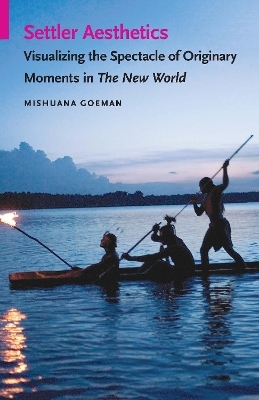
Settler Aesthetics
Visualizing the Spectacle of Originary Moments in The New World
Seiten
2023
University of Nebraska Press (Verlag)
978-0-8032-9066-2 (ISBN)
University of Nebraska Press (Verlag)
978-0-8032-9066-2 (ISBN)
Mishuana Goeman examines Terrence Malick’s film The New World (2005) and the Pocahontas narrative, analyzing the settler structures and regimes of power that sustain colonialism and empire.
In Settler Aesthetics, an analysis of renowned director Terrence Malick’s 2005 film, The New World, Mishuana Goeman examines the continuity of imperialist exceptionalism and settler-colonial aesthetics. The story of Pocahontas has thrived for centuries as a cover for settler-colonial erasure, destruction, and violence against Native peoples, and Native women in particular. Since the romanticized story of the encounter and relationship between Pocahontas and Captain John Smith was first published, it has imprinted a whitewashed historical memory into the minds of Americans.
As one of the most enduring tropes of imperialist nostalgia in world history, Renaissance European invasions of Indigenous lands by settlers trades in a falsified “civilizational discourse” that has been a focus in literature for centuries and in films since their inception. Ironically, Malick himself was a symbol of the New Hollywood in his early career, but with The New World he created a film that serves as a buttress for racial capitalism in the Americas. Focusing on settler structures, the setup of regimes of power, sexual violence and the gendering of colonialism, and the sustainability of colonialism and empires, Goeman masterfully peels away the visual layers of settler logics in The New World, creating a language in Native American and Indigenous studies for interpreting visual media.
In Settler Aesthetics, an analysis of renowned director Terrence Malick’s 2005 film, The New World, Mishuana Goeman examines the continuity of imperialist exceptionalism and settler-colonial aesthetics. The story of Pocahontas has thrived for centuries as a cover for settler-colonial erasure, destruction, and violence against Native peoples, and Native women in particular. Since the romanticized story of the encounter and relationship between Pocahontas and Captain John Smith was first published, it has imprinted a whitewashed historical memory into the minds of Americans.
As one of the most enduring tropes of imperialist nostalgia in world history, Renaissance European invasions of Indigenous lands by settlers trades in a falsified “civilizational discourse” that has been a focus in literature for centuries and in films since their inception. Ironically, Malick himself was a symbol of the New Hollywood in his early career, but with The New World he created a film that serves as a buttress for racial capitalism in the Americas. Focusing on settler structures, the setup of regimes of power, sexual violence and the gendering of colonialism, and the sustainability of colonialism and empires, Goeman masterfully peels away the visual layers of settler logics in The New World, creating a language in Native American and Indigenous studies for interpreting visual media.
Mishuana Goeman (Tonawanda Band of Seneca) is a professor and chair of the Department of Indigenous Studies at the University at Buffalo. She is the author of Mark My Words: Native Women Mapping Our Nations.
List of Illustrations
Series Editors’ Preface
Acknowledgments
Introduction: The Spectacle of Originary Moments
1. The Consumption of Mythic Romance and Innocence
2. Settler Aesthetics and the Making of Cinematic Geographies
3. Filmic Apologies and Indigenous Labor
4. The “New World” of Race, U.S. Law, and the Politics of Recognition
Conclusion: Undoing the Spectacle
Notes
Bibliography
Index
| Erscheinungsdatum | 18.10.2023 |
|---|---|
| Reihe/Serie | Indigenous Films |
| Zusatzinfo | 7 illustrations, 1 chart, index |
| Verlagsort | Lincoln |
| Sprache | englisch |
| Maße | 140 x 216 mm |
| Themenwelt | Geschichte ► Teilgebiete der Geschichte ► Kulturgeschichte |
| Sozialwissenschaften ► Ethnologie | |
| Sozialwissenschaften ► Kommunikation / Medien ► Medienwissenschaft | |
| Sozialwissenschaften ► Soziologie | |
| ISBN-10 | 0-8032-9066-7 / 0803290667 |
| ISBN-13 | 978-0-8032-9066-2 / 9780803290662 |
| Zustand | Neuware |
| Informationen gemäß Produktsicherheitsverordnung (GPSR) | |
| Haben Sie eine Frage zum Produkt? |
Mehr entdecken
aus dem Bereich
aus dem Bereich
der stille Abschied vom bäuerlichen Leben in Deutschland
Buch | Hardcover (2023)
C.H.Beck (Verlag)
23,00 €
vom Mittelalter bis zur Gegenwart
Buch | Softcover (2024)
C.H.Beck (Verlag)
12,00 €


